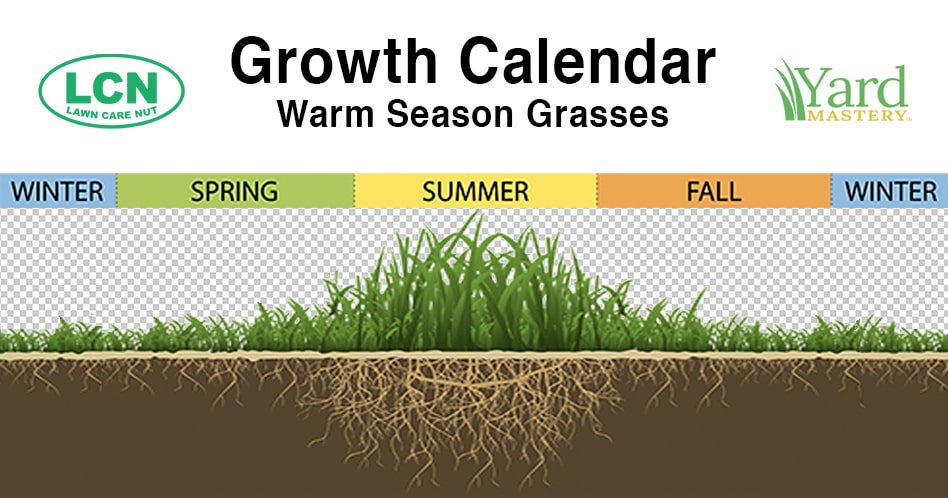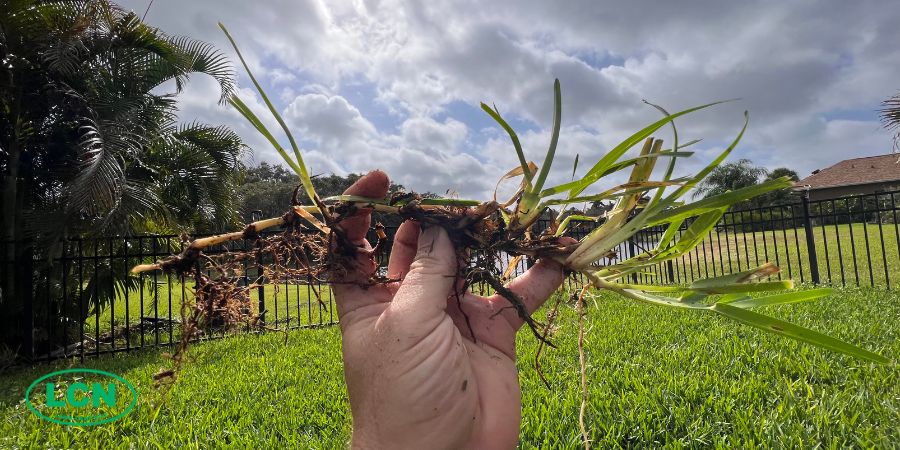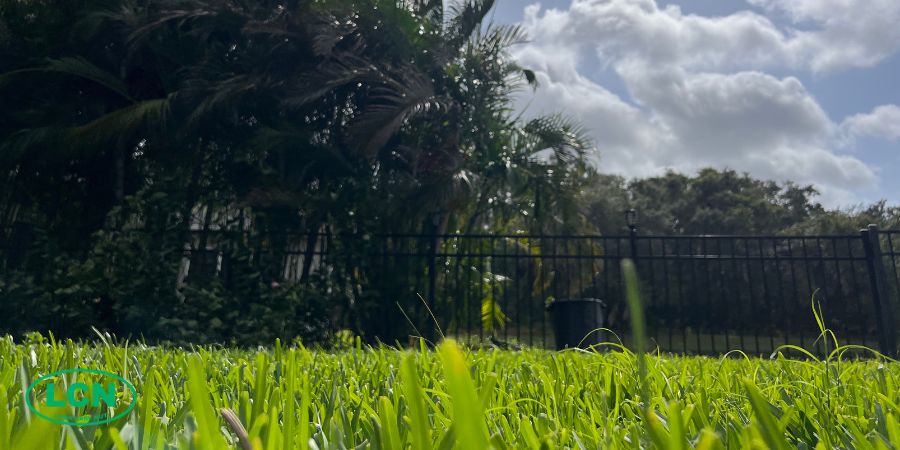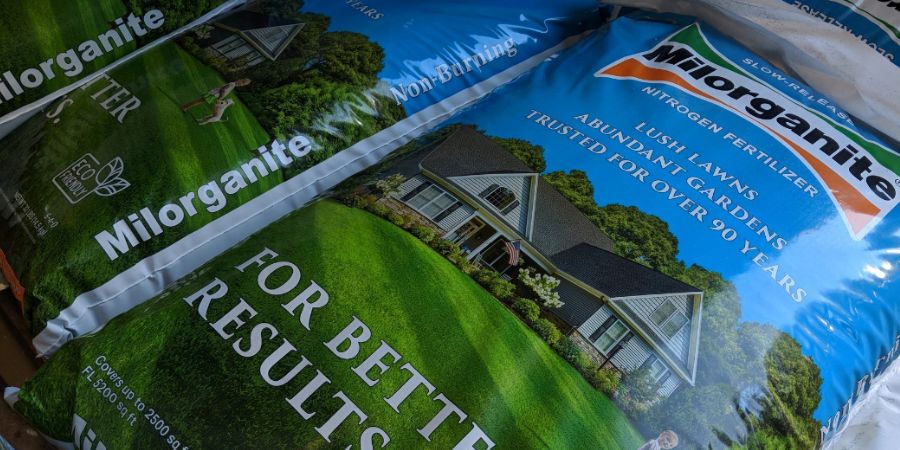Fall Lawn Strategy for Southern Lawns
- "The Lawn Care Nut"October 14, 2023
Autumn: it’s a time when things cool down, we get some relief from humidity, and the leaves on the trees change. That’s what most people think about unless you live in the South. Things are much much different here and depending on how far south you are, such as Florida or anywhere along the Gulf Coast, your autumn is quite a bit different, especially when it comes to your lawn care strategy. I’m talking about those of us down here with warm-season turf, like St Augustine grass, Bermuda, Zoysia, Centipede, and Bahia. We need a specific strategy.
Let’s take a look at the natural growth cycle of warm-season turf during the season.

This graphic illustrates the time of year that our turf is growing and spreading the most. That’s the middle of summer.
Remember, our lawns grow and spread by sending out runners called rhizomes and stolons. They creep across and just under the ground and send up grass blades as they go. If you have a thick warm season lawn, what you are actually seeing are thousands of these runners that have woven themselves together to create a dense mat of turf. This dense matt literally chokes our competition weeds.
Sending out these runners and maintaining them as they get longer and longer requires a lot of fuel and as you know, plants make their own “fuel” from the sun. It’s called “photosynthesis” and essentially what it means is the plants convert that sunlight and carbon dioxide into sugars (carbohydrates) that are sent downward to the roots to support the expansion of the plant.

This St Augustine stolon in my lawn in South Florida is still full of vigor but will begin slowing down over the next 4-5 weeks.
In return, the roots grab nutrients and water from the soil to send back up the plant to support more photosynthesis activities. It’s a beautiful thing!
Summer is the time when the days are the longest. Here in Florida, I love summer because sunsets are very close to 9 pm. I love the long days and so does your lawn. The more sun, the more fuel, the thicker the lawn gets.
Now that we are into the fall time, things are changing. You may notice your turf starting to pull back. St Augustine and Bermuda will start to thin out just a little as the days get shorter and shorter. This is normal.
Eventually, when the days get short enough, and the temperatures start to drop at the same time, that will be a signal to your lawn to go into winter dormancy. If you live anywhere outside of South Florida or Southern Texas, your lawn will probably go dormant sometime around Thanksgiving.
Your Southern Lawn Is Vulnerable When Dormant
A lawn that is dormant is vulnerable. The reason is that it can’t regrow if damage occurs. You see, the greatest advantage that warm-season turf has are those rhizomes and stolons. Their aggressive nature allows them to heal up or re-grow into areas where damage occurs. Thin spots in summer fill in within a few days sometimes. But in winter, it’s different. The grass is sleeping out in the open with no protection and no defense. Winter winds whip across it and dry it out, further causing it to recede.

Cloud cover in fall also blocks sunlight and slows the turf down even faster, triggering it to go into winter dormancy.
Fall Lawn Tips for Warm Season Turf
If you’ve been caring for your lawn for any amount of time, you know that this time of year you are only having to mow about once every 7-10 days whereas just 2 months ago it seemed like you had to mow twice per week just to barely keep up. A slower-growing, receding lawn needs some outside intervention from you!
Apply Pre-Emergent Herbicides in Fall
One of the most important applications you can make in the fall is a pre-emergent herbicide application. Pre-emergents are herbicides that prevent weeds from even showing up in the first place. You apply these prior to winter and you get some added protection all during the winter when your lawn is dormant. It’s the very best defense you can play.
You want to look for products with active ingredients dithiopyr, prodiamine or pendimethalin. These can help stop opportunistic weeds like poa annua (annual bluegrass), chickweed, hairy bittercress, and henbit. All of these weeds are known as “winter annuals” and their nature is to germinate in the fall time, grow all winter, and take over, then in spring, just as your warm season turf is starting to wake up, they drop thousands of seeds before dying of heat in the later spring. Those seeds remain dormant in the lawn all summer and germinate and grow in the fall, starting the process all over again.
There is nothing worse than looking at a dormant warm-season lawn pock-marked with bright green weeds all winter. (in my opinion anyway).
If you are wondering when the best time to apply pre-emergent is, it’s right now. Anytime in October is perfect because you will get 3-4 months of protection depending on which product and what rate you choose. Throw down your pre-emergent now and get it watered in. Your defensive strategy is now set up!
Fertilizing Warm-Season Grasses In Fall
We do still want to fertilize in the fall time, but we want to be cognizant of the amount of nitrogen we are applying. That is because nitrogen stimulates green growth and while that’s definitely a good thing, we don’t want to push a lawn too hard when it’s naturally trying to slow down and head into dormancy.
Roots, however, do not go dormant if your ground does not freeze. Even if your lawn is brown and dormant in winter, the roots will still be somewhat active and so will the microbes and other life that live and subsist around them. In this case, some potassium can be helpful to help the roots manage through the stresses of winter.

You can fertilize your lawn with Milorganite here in the fall time as long as you are still mowing at least every 7-10 days. Just keep it to a minimal rate so as not to push too much nitrogen on the lawn this late. 10lbs/1,000 of Milo will give you just under ½ lb. of slow-release nitrogen per 1,000 sq ft and that would be a good application rate for fall. You can make this application on the same day as your pre-emergent as a final feeding of the season. You’ll also get a little iron in there to extend the green color of your lawn a little longer than everyone else which is a nice bonus.
Watering Your Lawn All Winter
As I mentioned above the roots and organisms in the soil are still active all winter, which means adequate moisture is needed to keep their environment healthy and thriving. If you allow your soil to completely dry out over winter, you will experience some dead loss. That’s because winds whip across the open, dormant lawn and such moisture both from the soil and the grass plant itself. If grass plants are allowed to completely dry out, they can die rather quickly. My advice is to irrigate your dormant warm-season lawn with ½” water every 7-10 days or so. If that is too much for you, please try and get down at least ½” every two weeks at the least. You’ll find that winter watering will help your lawn get started and green up the following spring much faster than everyone else’s.
Should You Leave Leaves on Your Lawn?
The last tip is about leaf cover. Make sure to keep it clean. My general feeling is that mulching leaves into the lawn is a good thing, and it is. They provide organic material to the soil which the microbes love. However, in winter, when nothing is really growing, if you leave them out there they can get matted down into the canopy and complete for space and leave dead spots in the spring. So be sure to keep the leaves mulched up really well all winter, or just rake them and remove them all together. Leaves tend to pile up if left out, and these piles will kill off spots of the lawn if left too long.
The last consideration is an obvious one but I want to say it anyway and that is “stay off the lawn when it’s dormant as much as possible.” Sure, if you are raking leaves you’re going to have to walk on it, that’s fine. But I also don’t recommend you play football on Thanksgiving day on top of a dormant lawn either. Since it’s dormant, it doesn’t have the resiliency that it would when it’s green and growing and so all that stomping around on it can also cause some dead loss that you won’t notice until spring.
I’ll see you in the lawn!

